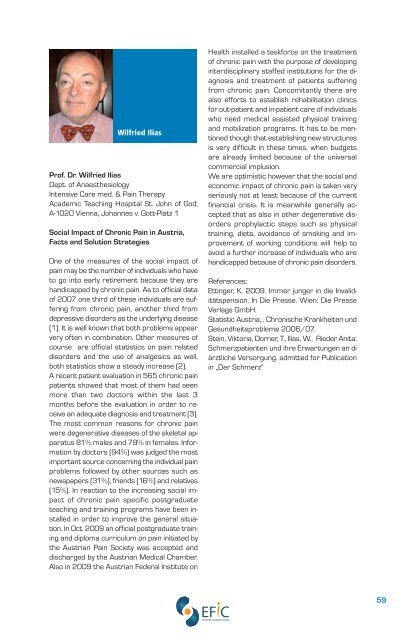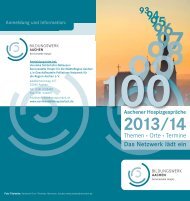First EFIC® Symposium Societal Impact of Pain - SIP
First EFIC® Symposium Societal Impact of Pain - SIP
First EFIC® Symposium Societal Impact of Pain - SIP
You also want an ePaper? Increase the reach of your titles
YUMPU automatically turns print PDFs into web optimized ePapers that Google loves.
Wilfried Ilias<br />
Pr<strong>of</strong>. Dr. Wilfried Ilias<br />
Dept. <strong>of</strong> Anaesthesiology<br />
Intensive Care med. & <strong>Pain</strong> Therapy<br />
Academic Teaching Hospital St. John <strong>of</strong> God;<br />
A-1020 Vienna, Johannes v. Gott-Platz 1<br />
Social <strong>Impact</strong> <strong>of</strong> Chronic <strong>Pain</strong> in Austria,<br />
Facts and Solution Strategies<br />
One <strong>of</strong> the measures <strong>of</strong> the social impact <strong>of</strong><br />
pain may be the number <strong>of</strong> individuals who have<br />
to go into early retirement because they are<br />
handicapped by chronic pain. As to <strong>of</strong>ficial data<br />
<strong>of</strong> 2007 one third <strong>of</strong> these individuals are suffering<br />
from chronic pain, another third from<br />
depressive disorders as the underlying disease<br />
(1). It is well known that both problems appear<br />
very <strong>of</strong>ten in combination. Other measures <strong>of</strong><br />
course are <strong>of</strong>ficial statistics on pain related<br />
disorders and the use <strong>of</strong> analgesics as well,<br />
both statistics show a steady increase (2).<br />
A recent patient evaluation in 565 chronic pain<br />
patients showed that most <strong>of</strong> them had seen<br />
more than two doctors within the last 3<br />
months before the evaluation in order to receive<br />
an adequate diagnosis and treatment (3).<br />
The most common reasons for chronic pain<br />
were degenerative diseases <strong>of</strong> the skeletal apparatus<br />
81% males and 79% in females. Information<br />
by doctors (94%) was judged the most<br />
important source concerning the individual pain<br />
problems followed by other sources such as<br />
newspapers (31%), friends (16%) and relatives<br />
(15%). In reaction to the increasing social impact<br />
<strong>of</strong> chronic pain specific postgraduate<br />
teaching and training programs have been installed<br />
in order to improve the general situation.<br />
In Oct. 2009 an <strong>of</strong>ficial postgraduate training<br />
and diploma curriculum on pain initiated by<br />
the Austrian <strong>Pain</strong> Society was accepted and<br />
discharged by the Austrian Medical Chamber.<br />
Also in 2009 the Austrian Federal Institute on<br />
Health installed a taskforce on the treatment<br />
<strong>of</strong> chronic pain with the purpose <strong>of</strong> developing<br />
interdisciplinary staffed institutions for the diagnosis<br />
and treatment <strong>of</strong> patients suffering<br />
from chronic pain. Concomitantly there are<br />
also efforts to establish rehabilitation clinics<br />
for out-patient and in-patient care <strong>of</strong> individuals<br />
who need medical assisted physical training<br />
and mobilization programs. It has to be mentioned<br />
though that establishing new structures<br />
is very difficult in these times, when budgets<br />
are already limited because <strong>of</strong> the universal<br />
commercial implusion.<br />
We are optimistic however that the social and<br />
economic impact <strong>of</strong> chronic pain is taken very<br />
seriously not at least because <strong>of</strong> the current<br />
financial crisis. It is meanwhile generally accepted<br />
that as also in other degenerative disorders<br />
prophylactic steps such as physical<br />
training, diets, avoidance <strong>of</strong> smoking and improvement<br />
<strong>of</strong> working conditions will help to<br />
avoid a further increase <strong>of</strong> individuals who are<br />
handicapped because <strong>of</strong> chronic pain disorders.<br />
References:<br />
Ettinger, K. 2009. Immer junger in die Invaliditätspension.<br />
In Die Presse. Wien: Die Presse<br />
Verlags GmbH.<br />
Statistic Austria, . Chronische Krankheiten und<br />
Gesundheitsprobleme 2006/07.<br />
Stein, Viktoria, Dorner, T., Ilias, W., Rieder Anita:<br />
Schmerzpatienten und ihre Erwartungen an di<br />
ärztliche Versorgung. admitted for Publication<br />
in „Der Schmerz“<br />
59






